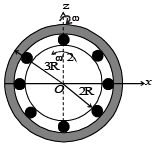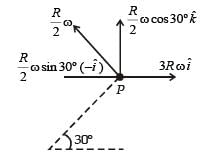JEE Exam > JEE Questions > The figure shows a system consisting of (i) a...
Start Learning for Free
The figure shows a system consisting of (i) a ring of outer radius 3R rolling clockwise without slipping on a horizontal surface with angular speed ω and (ii) an inner disc of radius 2R rotating anti-clockwise with angular speed ω/2. The ring and disc are separated by frictionless ball bearings. The point P on the inner disc is at a distance R from the origin, where OP makes an angle of 30° with the horizontal. Then with respect to the horizontal surface,

- a)the point O has linear velocity

- b)the point P has linear velocity

- c)the point P has linear velocity

- d)the point P has linear velocity

Correct answer is option 'A,B'. Can you explain this answer?
Verified Answer
The figure shows a system consisting of (i) a ring of outer radius 3R ...
For rolling motion, the velocity of the point of contact with respect to the surface should be zero. For this


A shown in the figure, the point P will have two velocities

 making an angle of 30º with the vertical due to rotation
making an angle of 30º with the vertical due to rotation


|
Explore Courses for JEE exam
|

|
Similar JEE Doubts
The figure shows a system consisting of (i) a ring of outer radius 3R rolling clockwise without slipping on a horizontal surface with angular speed ω and (ii) an inner disc of radius 2R rotating anti-clockwise with angular speed ω/2. The ring and disc are separated by frictionless ball bearings. The point P on the inner disc is at a distance R from the origin, where OP makes an angle of 30° with the horizontal. Then with respect to the horizontal surface,a)the point O has linear velocity b)the point P has linear velocity c)the point P has linear velocity d)the point P has linear velocity Correct answer is option 'A,B'. Can you explain this answer?
Question Description
The figure shows a system consisting of (i) a ring of outer radius 3R rolling clockwise without slipping on a horizontal surface with angular speed ω and (ii) an inner disc of radius 2R rotating anti-clockwise with angular speed ω/2. The ring and disc are separated by frictionless ball bearings. The point P on the inner disc is at a distance R from the origin, where OP makes an angle of 30° with the horizontal. Then with respect to the horizontal surface,a)the point O has linear velocity b)the point P has linear velocity c)the point P has linear velocity d)the point P has linear velocity Correct answer is option 'A,B'. Can you explain this answer? for JEE 2025 is part of JEE preparation. The Question and answers have been prepared according to the JEE exam syllabus. Information about The figure shows a system consisting of (i) a ring of outer radius 3R rolling clockwise without slipping on a horizontal surface with angular speed ω and (ii) an inner disc of radius 2R rotating anti-clockwise with angular speed ω/2. The ring and disc are separated by frictionless ball bearings. The point P on the inner disc is at a distance R from the origin, where OP makes an angle of 30° with the horizontal. Then with respect to the horizontal surface,a)the point O has linear velocity b)the point P has linear velocity c)the point P has linear velocity d)the point P has linear velocity Correct answer is option 'A,B'. Can you explain this answer? covers all topics & solutions for JEE 2025 Exam. Find important definitions, questions, meanings, examples, exercises and tests below for The figure shows a system consisting of (i) a ring of outer radius 3R rolling clockwise without slipping on a horizontal surface with angular speed ω and (ii) an inner disc of radius 2R rotating anti-clockwise with angular speed ω/2. The ring and disc are separated by frictionless ball bearings. The point P on the inner disc is at a distance R from the origin, where OP makes an angle of 30° with the horizontal. Then with respect to the horizontal surface,a)the point O has linear velocity b)the point P has linear velocity c)the point P has linear velocity d)the point P has linear velocity Correct answer is option 'A,B'. Can you explain this answer?.
The figure shows a system consisting of (i) a ring of outer radius 3R rolling clockwise without slipping on a horizontal surface with angular speed ω and (ii) an inner disc of radius 2R rotating anti-clockwise with angular speed ω/2. The ring and disc are separated by frictionless ball bearings. The point P on the inner disc is at a distance R from the origin, where OP makes an angle of 30° with the horizontal. Then with respect to the horizontal surface,a)the point O has linear velocity b)the point P has linear velocity c)the point P has linear velocity d)the point P has linear velocity Correct answer is option 'A,B'. Can you explain this answer? for JEE 2025 is part of JEE preparation. The Question and answers have been prepared according to the JEE exam syllabus. Information about The figure shows a system consisting of (i) a ring of outer radius 3R rolling clockwise without slipping on a horizontal surface with angular speed ω and (ii) an inner disc of radius 2R rotating anti-clockwise with angular speed ω/2. The ring and disc are separated by frictionless ball bearings. The point P on the inner disc is at a distance R from the origin, where OP makes an angle of 30° with the horizontal. Then with respect to the horizontal surface,a)the point O has linear velocity b)the point P has linear velocity c)the point P has linear velocity d)the point P has linear velocity Correct answer is option 'A,B'. Can you explain this answer? covers all topics & solutions for JEE 2025 Exam. Find important definitions, questions, meanings, examples, exercises and tests below for The figure shows a system consisting of (i) a ring of outer radius 3R rolling clockwise without slipping on a horizontal surface with angular speed ω and (ii) an inner disc of radius 2R rotating anti-clockwise with angular speed ω/2. The ring and disc are separated by frictionless ball bearings. The point P on the inner disc is at a distance R from the origin, where OP makes an angle of 30° with the horizontal. Then with respect to the horizontal surface,a)the point O has linear velocity b)the point P has linear velocity c)the point P has linear velocity d)the point P has linear velocity Correct answer is option 'A,B'. Can you explain this answer?.
Solutions for The figure shows a system consisting of (i) a ring of outer radius 3R rolling clockwise without slipping on a horizontal surface with angular speed ω and (ii) an inner disc of radius 2R rotating anti-clockwise with angular speed ω/2. The ring and disc are separated by frictionless ball bearings. The point P on the inner disc is at a distance R from the origin, where OP makes an angle of 30° with the horizontal. Then with respect to the horizontal surface,a)the point O has linear velocity b)the point P has linear velocity c)the point P has linear velocity d)the point P has linear velocity Correct answer is option 'A,B'. Can you explain this answer? in English & in Hindi are available as part of our courses for JEE.
Download more important topics, notes, lectures and mock test series for JEE Exam by signing up for free.
Here you can find the meaning of The figure shows a system consisting of (i) a ring of outer radius 3R rolling clockwise without slipping on a horizontal surface with angular speed ω and (ii) an inner disc of radius 2R rotating anti-clockwise with angular speed ω/2. The ring and disc are separated by frictionless ball bearings. The point P on the inner disc is at a distance R from the origin, where OP makes an angle of 30° with the horizontal. Then with respect to the horizontal surface,a)the point O has linear velocity b)the point P has linear velocity c)the point P has linear velocity d)the point P has linear velocity Correct answer is option 'A,B'. Can you explain this answer? defined & explained in the simplest way possible. Besides giving the explanation of
The figure shows a system consisting of (i) a ring of outer radius 3R rolling clockwise without slipping on a horizontal surface with angular speed ω and (ii) an inner disc of radius 2R rotating anti-clockwise with angular speed ω/2. The ring and disc are separated by frictionless ball bearings. The point P on the inner disc is at a distance R from the origin, where OP makes an angle of 30° with the horizontal. Then with respect to the horizontal surface,a)the point O has linear velocity b)the point P has linear velocity c)the point P has linear velocity d)the point P has linear velocity Correct answer is option 'A,B'. Can you explain this answer?, a detailed solution for The figure shows a system consisting of (i) a ring of outer radius 3R rolling clockwise without slipping on a horizontal surface with angular speed ω and (ii) an inner disc of radius 2R rotating anti-clockwise with angular speed ω/2. The ring and disc are separated by frictionless ball bearings. The point P on the inner disc is at a distance R from the origin, where OP makes an angle of 30° with the horizontal. Then with respect to the horizontal surface,a)the point O has linear velocity b)the point P has linear velocity c)the point P has linear velocity d)the point P has linear velocity Correct answer is option 'A,B'. Can you explain this answer? has been provided alongside types of The figure shows a system consisting of (i) a ring of outer radius 3R rolling clockwise without slipping on a horizontal surface with angular speed ω and (ii) an inner disc of radius 2R rotating anti-clockwise with angular speed ω/2. The ring and disc are separated by frictionless ball bearings. The point P on the inner disc is at a distance R from the origin, where OP makes an angle of 30° with the horizontal. Then with respect to the horizontal surface,a)the point O has linear velocity b)the point P has linear velocity c)the point P has linear velocity d)the point P has linear velocity Correct answer is option 'A,B'. Can you explain this answer? theory, EduRev gives you an
ample number of questions to practice The figure shows a system consisting of (i) a ring of outer radius 3R rolling clockwise without slipping on a horizontal surface with angular speed ω and (ii) an inner disc of radius 2R rotating anti-clockwise with angular speed ω/2. The ring and disc are separated by frictionless ball bearings. The point P on the inner disc is at a distance R from the origin, where OP makes an angle of 30° with the horizontal. Then with respect to the horizontal surface,a)the point O has linear velocity b)the point P has linear velocity c)the point P has linear velocity d)the point P has linear velocity Correct answer is option 'A,B'. Can you explain this answer? tests, examples and also practice JEE tests.

|
Explore Courses for JEE exam
|

|
Signup for Free!
Signup to see your scores go up within 7 days! Learn & Practice with 1000+ FREE Notes, Videos & Tests.
























